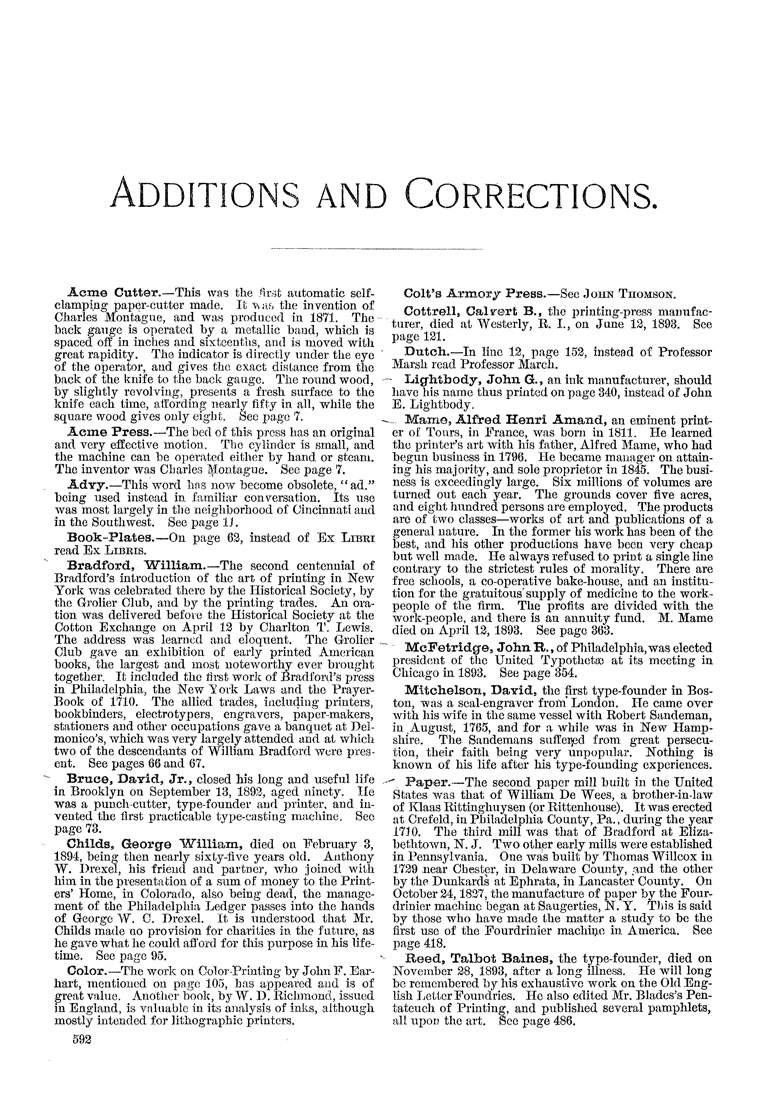Additions and Corrections.
Acme Cutter,—This was the first automatic self-
clamping paper-cutter made. It w ap, the invention of
Charles "Montague, and was produced in 1871. The -
back gauge is operated by a metallic band, which is
spaced off in inches and sixteenths, and is moved with
great rapidity. Tho indicator is directly under the eye
of the operator, and gives the exact distance from the
back of the knife to the back gauge. The round wood,
by slightly revolving, presents a fresh surface to the
knife each time, aff'ording nearly fifty in all, while the
square wood gives only eight. See pa-ge 7.
Acme Press.—The bed of this press ha^ an original
and very effective motion. The cylinder is small, and
the machine can be operated either by hand or steam.
The inventor was Charles l^iontague. See page 7.
AdYy.—This word hos now become obsolete, ''ad."
being used instead in familiar conversation. Its use
was most largely in the neighborhood of Cincinnati and
in thc Southwest. See page IJ.
Book-Plates.—On page 62, instead of Ex Libui
read Ex Libris.
Bradford, William.—The second centennial of
Bradford's introduction of the art of printing in New
York was celebrated there by the Historical Society, by
the Grolier Club, and by the printing trades. An ora¬
tion was delivered before the Historical Society at the
Cotton Exchange on April 12 by Charlton T. Lewis.
The address was learned and eloquent. The Grolier .
Club gave an exhibition of early printed American
books, the largest and most noteworthy ever brought
together. It included the first worjt of Bradford's press
in Philadelphia, the New Y ork Laws and the Prayer-
Book of 1710. The allied trades, including printers,
bookbinders, electrotypers, engravers, pajier-makers,
stationers and other occupations gave a banquet at Del-
monico's, which was very largely attended and at which
two of the descendants of William Bradford were pres¬
ent. See pages 66 and 67.
Bruce, DaYidj Jr., closed his long and useful life
in Brooklyn on September 13, 1892, aged ninety. He
was a punch-cutter, type-founder and printer, and in¬
vented the first practicable type-casting machine. See
page 73.
ChildSs George TITilliani, died on February 3,
1894, being then nearly sixty-five years old. Anthony
W. Drexel, his friend, and par tuer, who joined with
him in the presentation of a sum of money to the Print¬
ers' Home, in Colorado, also being dead, the manage¬
ment of the Philadelphia Ledger passes into the hands
of George W. C. Drexel. It is understood that Mr.
Childs made no provision for charities in the future, as
he gave what he could aflord for this purpose in his life¬
time. See page 95.
Color.—The work on Color-Printing by John F. Ear¬
hart, mentioned on page 105, has appeared and is of
great value. Anotiier book, by W. D. Richmond, issued
in England, is valuable in its analysis of inks, although
mostly intended for lithographic printers.
592
Colt's Armory Press.—See John TnoMsoN.
Cottrell, Calvert B., the printing-press manufac¬
turer, died at Westerly, R. I., on June 12, 1893. See
page 121.
Dutch.—In line 12, page 152, instead of Professor
Marsh read Professor March.
- liightbody, John G., an ink manufacturer, should
have his name thus printed on page 340, instead of John
E. Lightbody.
^- Mamo, Alfred Henri Amand, an eminent print¬
er of Tours, in France, was born in 1811. He learned
the printer's art with his father, Alfred Mame, who had
begun business in 1796. He became manager on attain¬
ing his majority, and sole proprietor in 1845. The busi¬
ness is exceedingly large. Six millions of volumes are
turned out each year. The grounds cover five acres,
and eight hundred persons are employed. The products
arc of two classes—works of art and publications of a
general nature. In the former his work has been of the
best, and his other productions have been very cheap
but well made. He always refused to print a single line
contrary to the strictest rules of morality. There are
free schools, a co-operative bake-house, and an institu¬
tion for the gratuitous"supply of medicine to the work¬
people of the firm. The profits are divided with the
work-people, and there is an annuity fund. M. Mame
died on Apiil 12, 1893. See page 363.
McFetridge, John H., of Philadelphia, was elected
president of the United Typothetae at its meeting in
Chicago in 1893. See page 354.
Mitchelson, DaYxd, the first type-founder in Bos¬
ton, was a seal-engraver from' London, He came over
with his wife in the same vessel with Robert Sandeman,
in August, 1765, and for a while was in New Hamp¬
shire. The Sandemans suffei^d from great persecu¬
tion, their faith being very unpopular. Nothing is
known of his life after his type-founding experiences.
'^"^ Paper.-—-The second paper mill built in the IJnited
States was that of William De Wees, a brother-in-law
of Klaas Rittinghuysen (or Rittenhouse), It was erected
at Crefeld, in Philadelphia County, Pa., during the year
1710. The third mill was that of Bradford at Eliza-
bethtown, N. J. Two other early mills were established
in Pennsylvania. One wa!s built by Thomas Willcox in
1729 near Chester, in Delaware County, and the other
by the Dunkards at Ephrata, in Lancaster County. On
October 24,1827, the manufacture of paper by the Four¬
drinier machine began at Saugerties, N. Y. This is said
hy those who have made the matter a study to be the
first use of the Fourdrinier machi^c in America. See
page 418.
Reeds Talbot Baines, the type-founder, died on
November 28, 1893, after a long illness. He will long
be remembered by his exhaustive work on the Old Eng¬
lish Letter Foundries. He also edited Mr. Blades's Pen¬
tateuch of Printing, and published several pamphlets,
all upon the art. See page 486.
|








